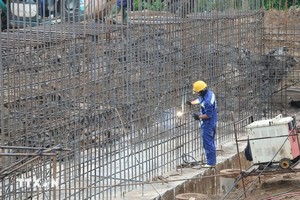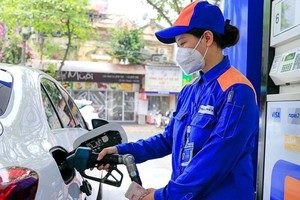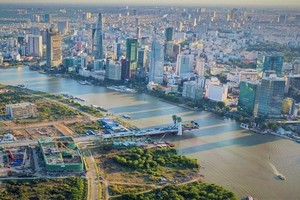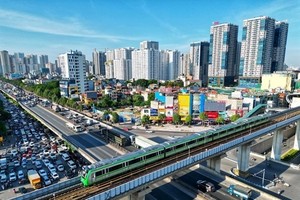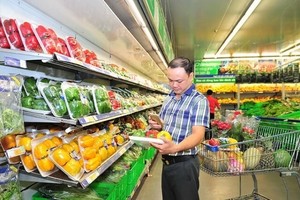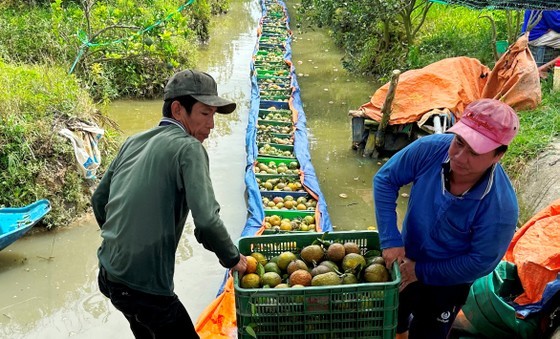 |
Farmers harvest king mandarins in Vinh Long Province. (Photo: SGGP) |
In the Mekong Delta, farmers used to abandon rice to grow jackfruit, and when the price of jackfruit dropped, they switched to planting durian massively. Now, with the risk of a sharp drop in durian prices, farmers do not know what to grow next, but the risk of chopping down durian trees is hardly unavoidable.
Running after the market
In Long An Province, many farmers are cutting down jackfruit and custard apple trees and leveling rice fields for durian cultivation. According to the statistics of the Department of Agriculture and Rural Development of Long An Province, by the end of 2022, the total area of durian in the province was over 438 hectares, of which 50 percent was newly planted. Localities that increased durian area include the districts of Tan Thanh, Moc Hoa, Thanh Hoa, Vinh Hung, and Kien Tuong Town. Although the area is expanding rapidly, only 36 hectares in two durian-growing areas in Tan Lap Commune, Tan Thanh District, have been granted export codes to the Chinese market. This is also the typical scenario in many provinces and cities in the Mekong Delta.
Over five years ago, Hau Giang Province warned of the risk of farmers planting king mandarin and jackfruit. Not only in Hau Giang Province, the sad story of rescuing king mandarin also occurred in Vinh Long Province. Now, the wave of cutting down jackfruit and switching to durian cultivation is happening in Long An, Tien Giang, and some localities in the Mekong Delta. In the past ten years, the trend of shifting from rice to fruit tree cultivation has increased significantly, driven by market demand and profits.
In the North, the planting and cutting situation has also been happening continuously for many years. For example, in the provinces of Bac Giang, Hoa Binh, Yen Bai, and Phu Tho, when the price of lychee drops, many places have cut down lychee trees to switch to growing hesperidium fruit trees, mostly oranges, and pomelos, leading to oversupply and no market demand. In 2022, the price of pomelos sold at the orchards in Hoa Binh Province was only VND5,000 per fruit (previously VND20,000-VND30,000 per fruit), so at the beginning of 2023, many orchard owners cut down their pomelo trees. Meanwhile, at the famous Cao Phong orange grove in Hoa Binh Province, there were only over 900 hectares of orange trees in 2010, but by 2021, this figure skyrocketed to nearly 3,000 hectares. However, in 2022, farmers cleared nearly half of the orange groves, leaving only about 1,700 hectares, to switch to growing bananas, sugarcane, and pineapples.
While farmers in Hoa Binh Province were cutting down oranges to switch to growing bananas and sugarcane, many farmers in Lao Cai and Dien Bien provinces were cutting down bananas and sugarcane to switch to growing pineapples, with a total area of about 1,900 hectares. And now even pineapples are unsalable. From 2020-2023, the price of pineapples continuously plummeted from VND7,000-VND8,000 per kg to only VND3,000-VND4,000 per kg (poor quality pineapples fetched only VND2,000 per kg, sometimes even VND1,000 per kg). However, the factories still refuse to buy, so many local farmers are gradually destroying their pineapples to switch to growing tea and cinnamon. This vicious cycle just keeps repeating.
According to statistics from the Crop Production Department, in the Mekong Delta region, the area of fruit trees continuously increased from 2010 to 2020. Specifically, in 2010, the total area of fruit trees in the region was over 287,000 hectares, which skyrocketed to nearly 378,000 hectares in 2020, with an average annual increase of nearly 10,000 hectares. Specifically, dragon fruit reached 23,700 hectares, an increase of 22,800 hectares; durian reached 24,900 hectares, an increase of 20,100 hectares. Among them, the area of jackfruit, which was almost negligible, has now soared to a staggering 30,000 hectares, an increase of 29,800 hectares.
Dr. Vo Huu Thoai, Director of the Southern Fruit Research Institute, shared that we should sympathize with poor people who live off their small gardens. When they grow a crop that brings low profit, they tend to cut it down to plant another crop. Meanwhile, businesses know how to calculate their investments. They reduce their investment when the price is low and reinvest when it is high. The cycle of planting, cutting, and planting again only occurs for disadvantaged people. "We advise people that when their agricultural products encounter low prices, they should not rush to destroy them. Instead, they should study the market and reduce their investment to lower production costs. They should wait for the price to rise and then take care of their crop. This way, they will reduce their losses compared to hastily cutting and investing in new crops," said Dr. Vo Huu Thoai.
However, recently, the price of jackfruit has dropped, and many farmers have rushed to cut down their jackfruit trees to plant durian trees because they run after the market. Some lucky farmers who have not yet cut down their jackfruit trees have seen the price rise again. At the end of 2022, when the price of jackfruit plummeted, and no one bought it, Nguyen Hoang Thai, a farmer in Tan Phuoc District, Tien Giang Province, abandoned his 5-hectare jackfruit plantation and intended to destroy it to switch to durian cultivation. But in 2023, the price of jackfruit increased again, and Thai quickly hired more laborers, fertilized, and took care of his jackfruit orchard again, hoping for a new harvest with a high yield and price. However, the jackfruit orchard was left uncared for a long time, and despite spending a lot of money, it still has not fully recovered.
Spontaneous fruit cultivation should be curtailed
The Department of Crop Production recognizes that the conversion of some areas to fruit trees, such as oranges, tangerines, pomelos, mangoes, and durians, has significantly increased due to their high economic efficiency. However, the extent of the converted crop area has not been fully accounted for. Production organization has not been aligned with local planning and direction and remains spontaneous. Renting rice fields to grow mandarins for quick and short-term exploitation is the most common form of this trend, causing instability in consumption. The area of jackfruit has soared in recent times due to high demand from the Chinese market, and the area of mandarins has also experienced similar situations, requiring consumption rescue efforts. However, when consumption is stagnant, the price to pay is too high, and orchard owners end up having to chop down their crops, eroding their own invested resources.
To successfully carry out the conversion of crop structures on rice land, localities need to clearly explain the effectiveness of converting crop structures on ineffective rice land to other crops to adapt to climate change. This includes focusing on connecting and inviting businesses to participate in production linkages, supplying good quality seeds, and ensuring stable consumption for farmers.
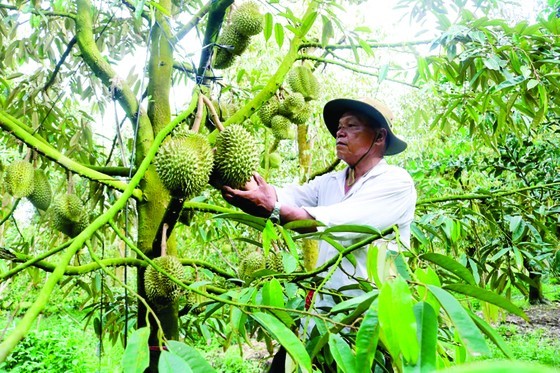 |
Farmers worry as durian prices tend to decline. (Photo: SGGP) |
The current situation of planting and then chopping down fruit trees is a reflection of the struggling fruit production chain, where the link between orchard owners and businesses providing market outlets has not been firmly established. According to Ms. Ngo Tuong Vy, the CEO of Chanh Thu Fruit Import and Export Corporation in Ben Tre Province, it is crucial for fruit growers in the Mekong Delta region to establish and maintain a robust fruit production that is linked to the planting area code for export to China.
Can Tho City currently has over 24,000 hectares of fruit trees, with durian being one of the main products occupying nearly 2,500 hectares and yielding over 8,000 tons. However, only 662 organizations and individuals have registered their planting area codes for durian on an area of nearly 571 hectares. Some scientists are concerned that China has only granted planting area codes for about 12,000 hectares of durian, whereas Vietnam has about 110,000 hectares of durian. This raises questions about the future consumption and production of durian in the remaining area. Moreover, some places in China have already begun harvesting durian, so it is uncertain whether orchard owners in the Mekong Delta are rushing to plant durian trees only to chop them down, like jackfruit and pomelo trees in recent years. The responsibility to answer this question lies with relevant ministries, departments, and local authorities.
Mr. Nguyen Nhu Cuong, Director of the Department of Crop Production under the Ministry of Agriculture and Rural Development, said that although Vietnam and China have signed a memorandum of understanding, opening up opportunities for official durian exports, the current mass planting in many localities poses a risk of excess supply and price instability. After the initial period, durian prices increased sharply from around VND70,000-VND80,000 per kg to VND100,000 per kg, sometimes even up to VND200,000 per kg, but recently, they have dropped quickly to below VND100,000 per kg. Such price fluctuation is a warning that if the planning is not followed correctly, durian may also need consumption rescue in the future, and the cycle of planting and chopping will repeat as it used to happen with jackfruit, pineapple, dragon fruit, passion fruit, and citrus trees.
The Ministry of Agriculture and Rural Development forecasts that in 2023, Vietnam's durian production will possibly reach 1 million tons. Meanwhile, in Decision No.4085 dated November 27, 2022, approving the National Key Fruit Tree Development Project until 2025 with an orientation towards 2030, the Ministry of Agriculture and Rural Development recommends that the durian cultivation area by then should only be at the level of 65,000-75,000 hectares, with a production volume of only 830,000-950,000 tons.
Director Nguyen Nhu Cuong stated that, in the face of the risk of durian planning failure, the Ministry of Agriculture and Rural Development has twice sent documents to localities warning that farmers should not plant durian massively in the Mekong Delta, the Southeast region, and Central Highlands. State management agencies do not have the authority to prohibit farmers from planting any certain fruit tree but only provide recommendations for farmers to comply with the planning to ensure sustainable development, stable prices, and markets. However, farmers must also comply with local planning. They cannot break the planning only to demand rescue solutions later.
